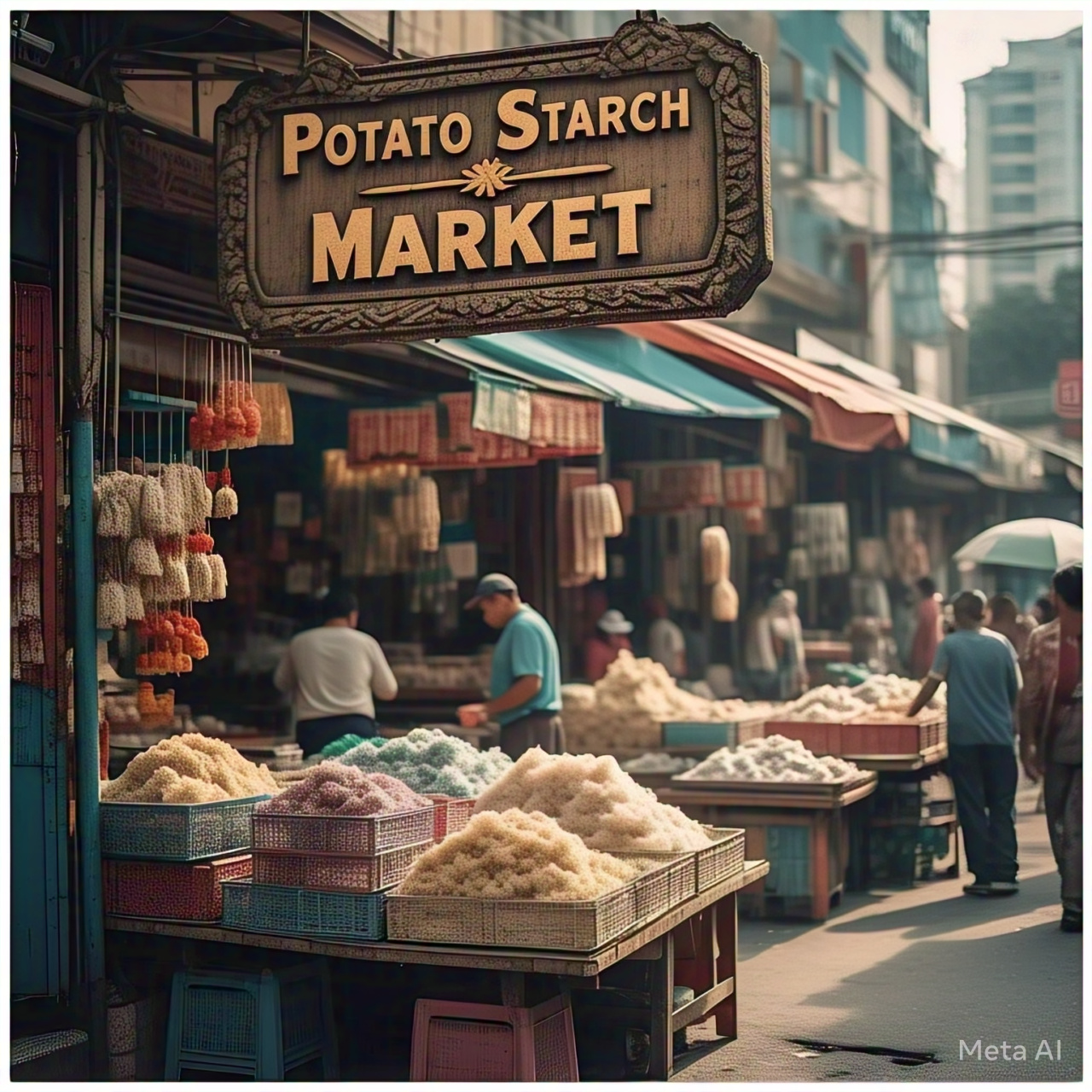Potato Starch Market : Key Drivers, Regional Insights & Forecast to 2033
Global Potato Starch Market Overview The global Potato Starch Market is projected to witness significant growth, with an expected market...

Global Potato Starch Market Overview
The global Potato Starch Market is projected to witness significant growth, with an expected market size of US$ 6.99 billion by 2033, up from US$ 4.71 billion in 2024, growing at a CAGR of 4.47% from 2025 to 2033. This growth is fueled by multiple factors, including the increasing demand for gluten-free products, the rise in vegan and vegetarian diets, expansion in food processing, sustainability initiatives, and the growing popularity of convenience foods. The market’s versatility across multiple sectors, including food, pharmaceuticals, textiles, and paper, ensures its continued development and relevance in various industries.
Factors Driving Growth in the Potato Starch Market
1. Vegan and Vegetarian Diets
One of the most significant trends in the potato starch market is the rise in plant-based diets. As more people embrace vegan and vegetarian lifestyles for health, environmental, and ethical reasons, the demand for plant-based ingredients has surged. Potato starch, being a plant-derived product, is in high demand for vegan and vegetarian-friendly foods such as dairy substitutes and plant-based meat alternatives. Its ability to add texture, bind ingredients, and improve the overall quality of plant-based products contributes to its growing market presence.
2. Expansion of the Food Processing Industry
The food processing industry is expanding at a rapid pace to meet the increasing demand for convenient, ready-to-eat meals. As a result, the demand for ingredients that enhance food texture, improve stability, and act as thickeners is on the rise. Potato starch, known for these attributes, is widely used in sauces, soups, baked goods, and snacks. The convenience food sector, driven by urbanization and busy lifestyles, further boosts the demand for processed foods that use potato starch as a primary ingredient.
3. Consumer Demand for Gluten-Free Products
With increasing health awareness, consumers are actively seeking gluten-free alternatives to traditional wheat-based ingredients. Potato starch, being naturally gluten-free, is gaining prominence as a key ingredient in gluten-free food products. This shift is particularly evident in baked goods, sauces, and soups, where potato starch is used for its texturizing and binding properties. The gluten-free trend is not only popular among those with celiac disease but also among health-conscious individuals opting for gluten-free diets.
4. The Clean-Label Movement
Consumers are becoming more discerning about the ingredients in their food, preferring clean-label products with simple and recognizable components. Potato starch, as a minimally processed ingredient derived from potatoes, aligns with this clean-label demand. It is considered a natural and transparent ingredient, appealing to consumers who prioritize health and sustainability in their food choices. This growing preference for clean-label products is contributing to the market’s growth, as manufacturers look to offer products that meet these consumer expectations.
Related Report
- North America Organic Starch Market Size and Share Analysis – Growth Trends and Forecast Report 2025-2033
- Cassava Starch Market, Size, Share, Global Forecast 2024-2030, Industry Trends, Growth, Insight, Top Companies Analysis
- Wheat Starch Market, Consumption & Global Forecast by (Native, Modified, Sweeteners), Countries, Applications, Companies
Challenges Facing the Potato Starch Market
1. Raw Material Supply Volatility
Potato starch production is highly sensitive to environmental factors, as potatoes are the primary raw material. Fluctuations in weather conditions, such as droughts or floods, can severely impact potato yields, resulting in supply shortages and price volatility. This unpredictability in raw material availability affects the stability of the potato starch market, leading to challenges in maintaining consistent pricing and supply. Moreover, diseases such as potato cyst nematodes can also disrupt potato production, further exacerbating these issues.
2. Competition from Alternative Starches
Potato starch faces growing competition from alternative starches like corn, tapioca, and wheat. These alternatives are often cheaper to produce and offer similar functionalities, such as thickening, stabilizing, and texturizing properties. For example, corn starch is widely used in paper manufacturing, food processing, and pharmaceuticals due to its affordability and versatility. As the demand for alternative starches increases, potato starch manufacturers must innovate to differentiate their products, focusing on quality, sustainability, and unique applications to maintain their competitive edge.
Regional Insights on the Potato Starch Market
United States
In the United States, the potato starch market is expanding gradually, driven by the increasing demand for processed foods, gluten-free products, and industrial applications. Potato starch is used extensively in food products like soups, sauces, and baked goods due to its ability to improve texture and stability. The growing health-conscious population seeking gluten-free options further fuels this demand. Additionally, potato starch’s use in non-food sectors such as paper and pharmaceuticals contributes to the market’s overall growth.
United Kingdom
The potato starch market in the United Kingdom is influenced by the rising demand for convenience foods and the popularity of gluten-free products. Potato starch plays a crucial role in processed snacks, soups, and sauces. It is also used extensively in the dairy and baking industries, where clean-label and gluten-free options are highly sought after. Moreover, the United Kingdom’s increasing focus on sustainable production methods aligns with the growing demand for eco-friendly ingredients like potato starch.
India
In India, the demand for potato starch is driven by the rising consumption of processed foods, the growing trend of gluten-free diets, and its wide range of industrial applications. Potato starch is used in the food industry to improve texture, stabilize products, and enhance the quality of snacks and baked goods. However, challenges such as price volatility, inconsistent potato supply, and competition from alternative starches like corn and tapioca need to be addressed for sustained growth in this market.
United Arab Emirates
The potato starch market in the UAE is expanding due to the increasing demand for processed foods, gluten-free products, and natural ingredients. Potato starch is widely used in the UAE’s food industry, especially in the preparation of sauces, soups, bakery goods, and snacks. The country’s growing foodservice sector and heightened health consciousness are key drivers of this market. Additionally, non-food industries such as paper, textiles, and pharmaceuticals are contributing to the overall market growth.
Market Forecast and Future Outlook
The global potato starch market is poised for continuous growth over the forecast period from 2025 to 2033, driven by consumer preferences for healthier, cleaner food options, and its extensive use across multiple industries. As demand for convenience foods and plant-based products continues to rise, potato starch will remain a vital ingredient. Additionally, its increasing use in non-food sectors such as paper and textiles, along with advancements in processing technologies, will ensure that the market remains dynamic and adaptable to changing consumer needs.
Conclusion
The global potato starch market is experiencing steady growth, with a projected market size of US$ 6.99 billion by 2033. Key drivers include the rising demand for gluten-free and clean-label products, the growth of the food processing industry, and the increasing popularity of plant-based diets. However, challenges such as raw material supply volatility and competition from alternative starches must be navigated. With continued innovation and the development of sustainable production methods, the potato starch market is expected to continue its upward trajectory.
For More Insights and Customization
For detailed insights, custom research, or further analysis, feel free to Request a Sample or Customization.







